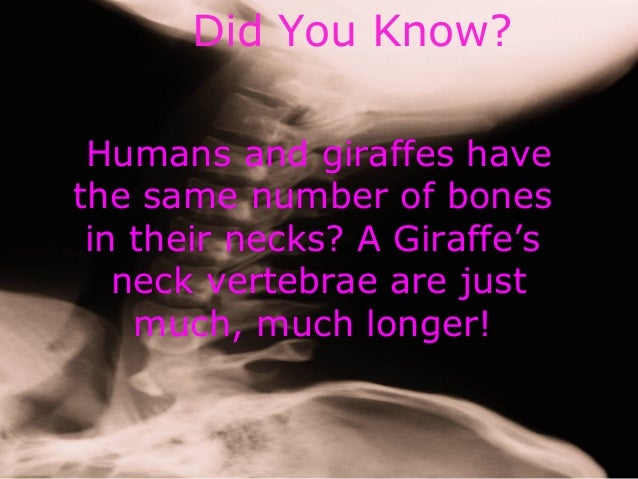Giraffes and humans have the same amount of neck bones

Giraffes and Humans Have the Same Amount of Neck Bones


When it comes to comparing animals to humans, we often find ourselves fascinated by the similarities and differences. One such interesting fact is that giraffes and humans share something unexpected - they have the same number of neck bones or vertebrae. Although their necks may appear incredibly different, with giraffes having long, elegant necks and humans having short and stocky necks, the underlying structure remains the same.
7 Cervical Vertebrae: The Common Denominator
Both giraffes and humans possess seven cervical vertebrae in their necks. These vertebrae provide support and flexibility, allowing movement and protection for the spinal cord. Despite the significant difference in neck length, the number of cervical vertebrae is consistent. In fact, most mammals, including dogs, cats, horses, and even whales, have seven neck bones.
As we delve deeper into this fascinating fact, we discover that the similarities between giraffes and humans extend beyond just the bone structure. Both species share a common ancestor, which drives the presence of common elements in their anatomy.
Why Do Giraffes Have Such Long Necks?
Giraffes are known for their impressively long necks, which enable them to reach foliage high up on trees that other herbivores cannot access. But what allows their necks to grow to such extraordinary lengths? The key lies in the elongation of their cervical vertebrae. Each individual vertebra can measure up to 28 centimeters long in an adult giraffe. Additionally, their necks are supported by powerful muscles and specialized cardiovascular adaptations that allow blood to flow efficiently even to the highest points, preventing any strain or damage.
The Evolutionary Connection
The shared cervical vertebrae count between giraffes and humans can be attributed to a common ancestor from over 100 million years ago. Through evolution, species have adapted to their particular environments and developed distinct traits. As giraffes evolved to survive in the African savannah, their ancestors faced challenges that shaped their unique anatomy, including the development of an elongated neck and specialized cardiovascular adaptations.
Linking Giraffes and Humans
Exploring the similarities between giraffes and humans not only provides fascinating insights into the natural world but also highlights the interconnectedness of all living organisms. By studying the anatomy and evolution of giraffes and humans, scientists gain a better understanding of the principles that govern life on Earth.
If you find this topic intriguing, you can delve deeper into the world of comparative anatomy by visiting the National History Museum’s article on how a mouse is like a giraffe here.
Related Posts
Quick Links
Legal Stuff

